Importance of Environment Management System in Australian Agricultural Sector
VerifiedAdded on 2023/06/05
|11
|2318
|223
AI Summary
This research paper focuses on the importance of Environment Management System in Australian Agricultural Sector. It identifies the research aim, objectives, and question related to the implementation of EMS in Australian agricultural sector. The paper provides literature review, research methodology, critical analysis, and recommendations.
Contribute Materials
Your contribution can guide someone’s learning journey. Share your
documents today.
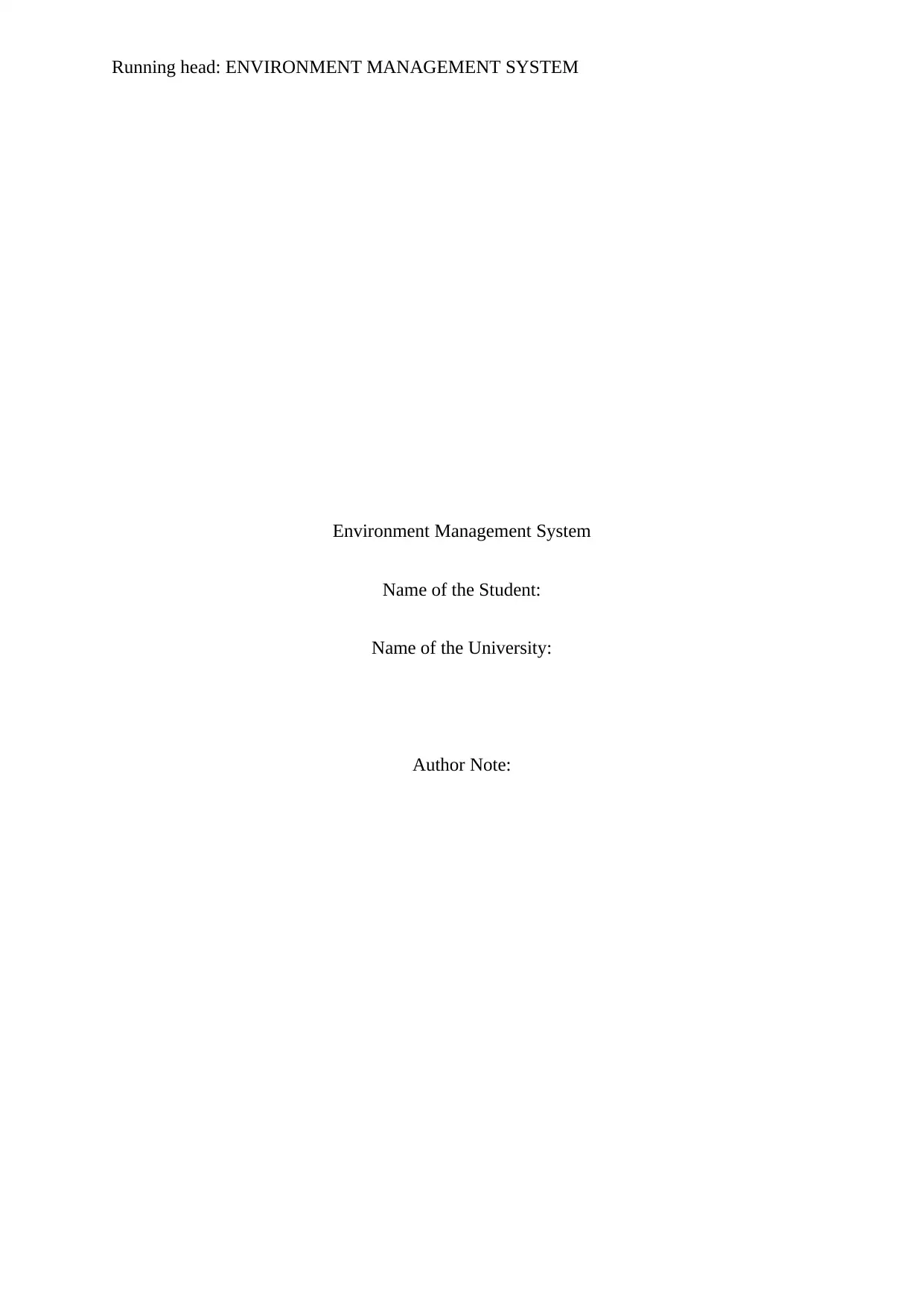
Running head: ENVIRONMENT MANAGEMENT SYSTEM
Environment Management System
Name of the Student:
Name of the University:
Author Note:
Environment Management System
Name of the Student:
Name of the University:
Author Note:
Secure Best Marks with AI Grader
Need help grading? Try our AI Grader for instant feedback on your assignments.
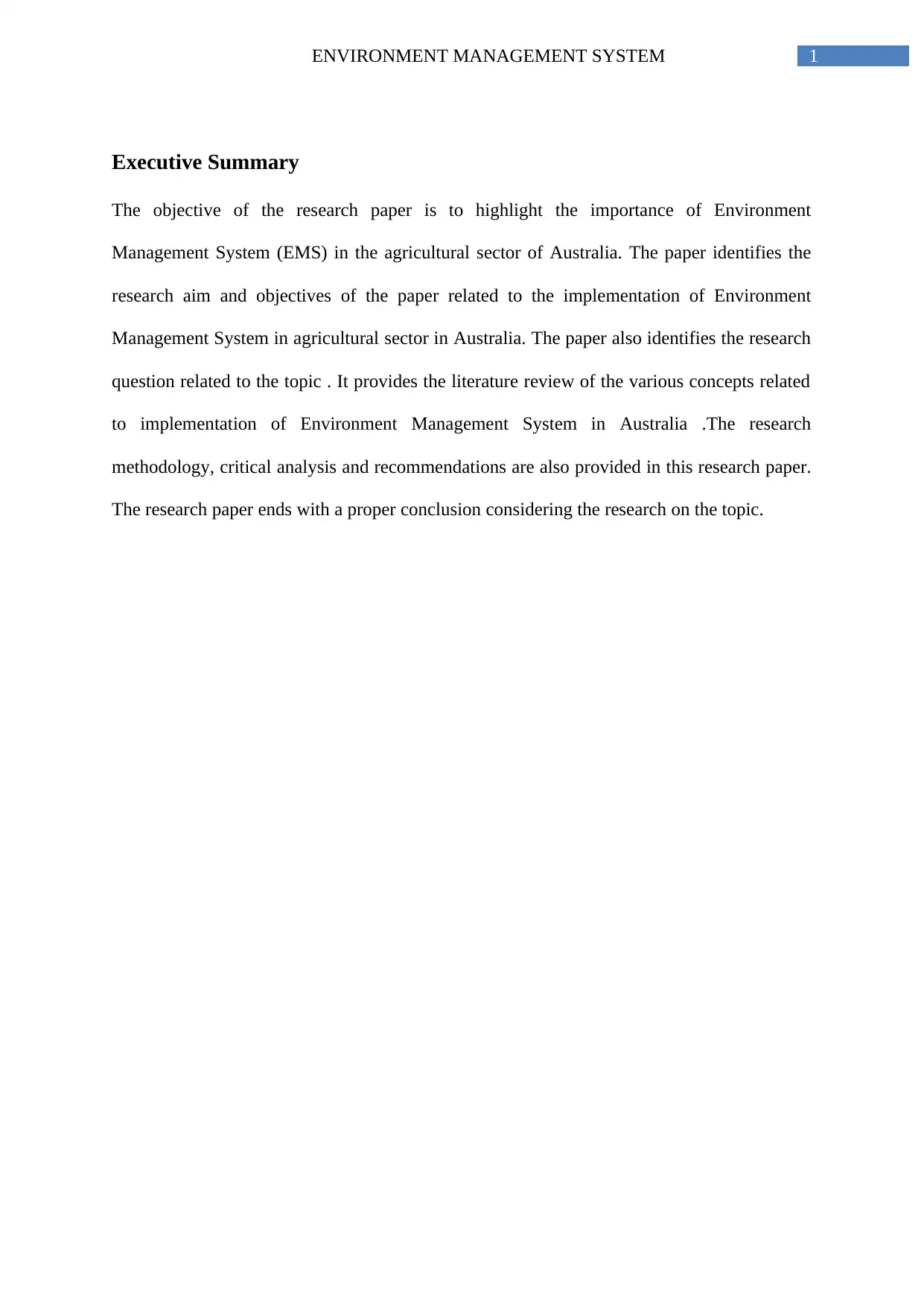
1ENVIRONMENT MANAGEMENT SYSTEM
Executive Summary
The objective of the research paper is to highlight the importance of Environment
Management System (EMS) in the agricultural sector of Australia. The paper identifies the
research aim and objectives of the paper related to the implementation of Environment
Management System in agricultural sector in Australia. The paper also identifies the research
question related to the topic . It provides the literature review of the various concepts related
to implementation of Environment Management System in Australia .The research
methodology, critical analysis and recommendations are also provided in this research paper.
The research paper ends with a proper conclusion considering the research on the topic.
Executive Summary
The objective of the research paper is to highlight the importance of Environment
Management System (EMS) in the agricultural sector of Australia. The paper identifies the
research aim and objectives of the paper related to the implementation of Environment
Management System in agricultural sector in Australia. The paper also identifies the research
question related to the topic . It provides the literature review of the various concepts related
to implementation of Environment Management System in Australia .The research
methodology, critical analysis and recommendations are also provided in this research paper.
The research paper ends with a proper conclusion considering the research on the topic.
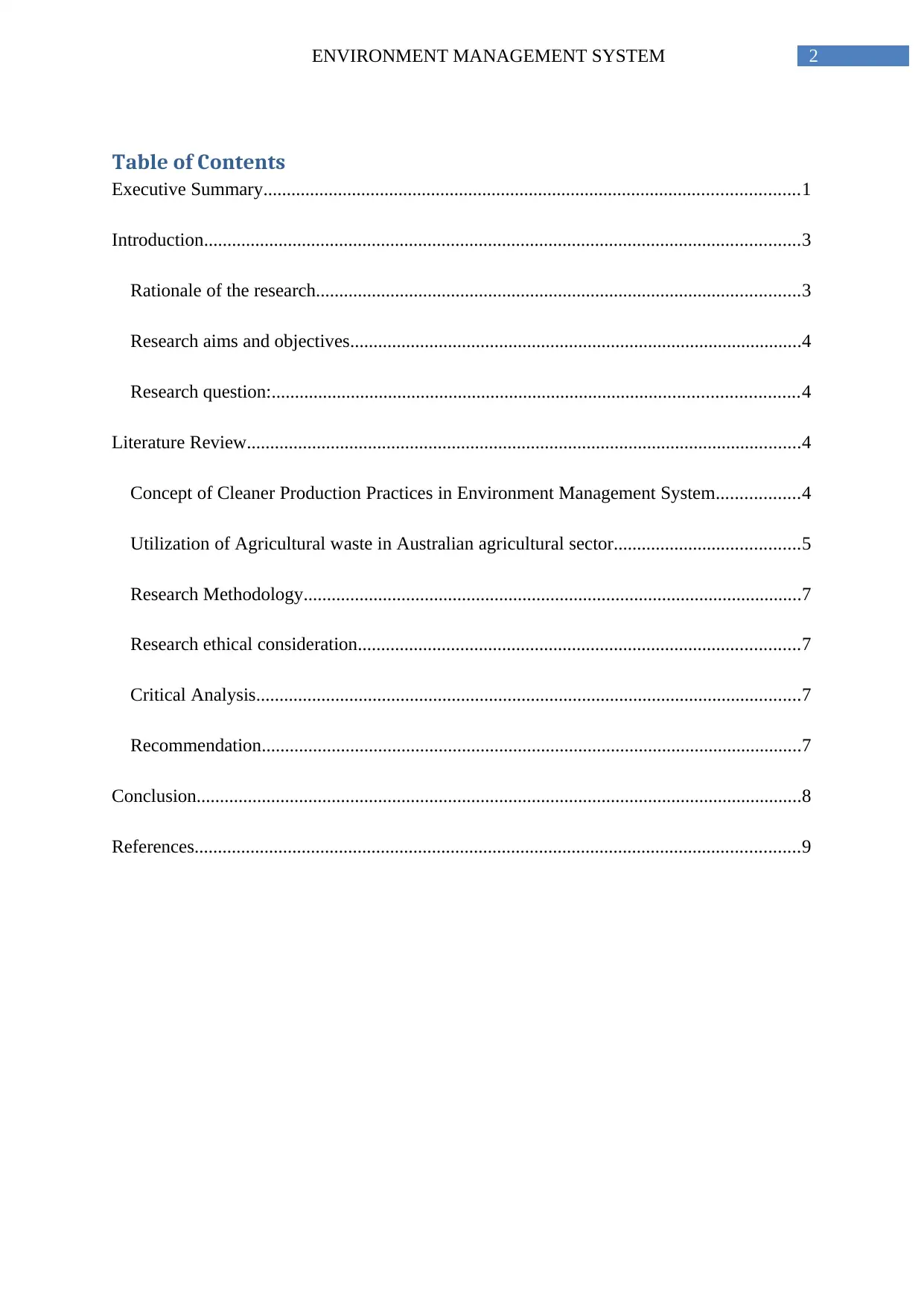
2ENVIRONMENT MANAGEMENT SYSTEM
Table of Contents
Executive Summary...................................................................................................................1
Introduction................................................................................................................................3
Rationale of the research........................................................................................................3
Research aims and objectives.................................................................................................4
Research question:.................................................................................................................4
Literature Review.......................................................................................................................4
Concept of Cleaner Production Practices in Environment Management System..................4
Utilization of Agricultural waste in Australian agricultural sector........................................5
Research Methodology...........................................................................................................7
Research ethical consideration...............................................................................................7
Critical Analysis.....................................................................................................................7
Recommendation....................................................................................................................7
Conclusion..................................................................................................................................8
References..................................................................................................................................9
Table of Contents
Executive Summary...................................................................................................................1
Introduction................................................................................................................................3
Rationale of the research........................................................................................................3
Research aims and objectives.................................................................................................4
Research question:.................................................................................................................4
Literature Review.......................................................................................................................4
Concept of Cleaner Production Practices in Environment Management System..................4
Utilization of Agricultural waste in Australian agricultural sector........................................5
Research Methodology...........................................................................................................7
Research ethical consideration...............................................................................................7
Critical Analysis.....................................................................................................................7
Recommendation....................................................................................................................7
Conclusion..................................................................................................................................8
References..................................................................................................................................9
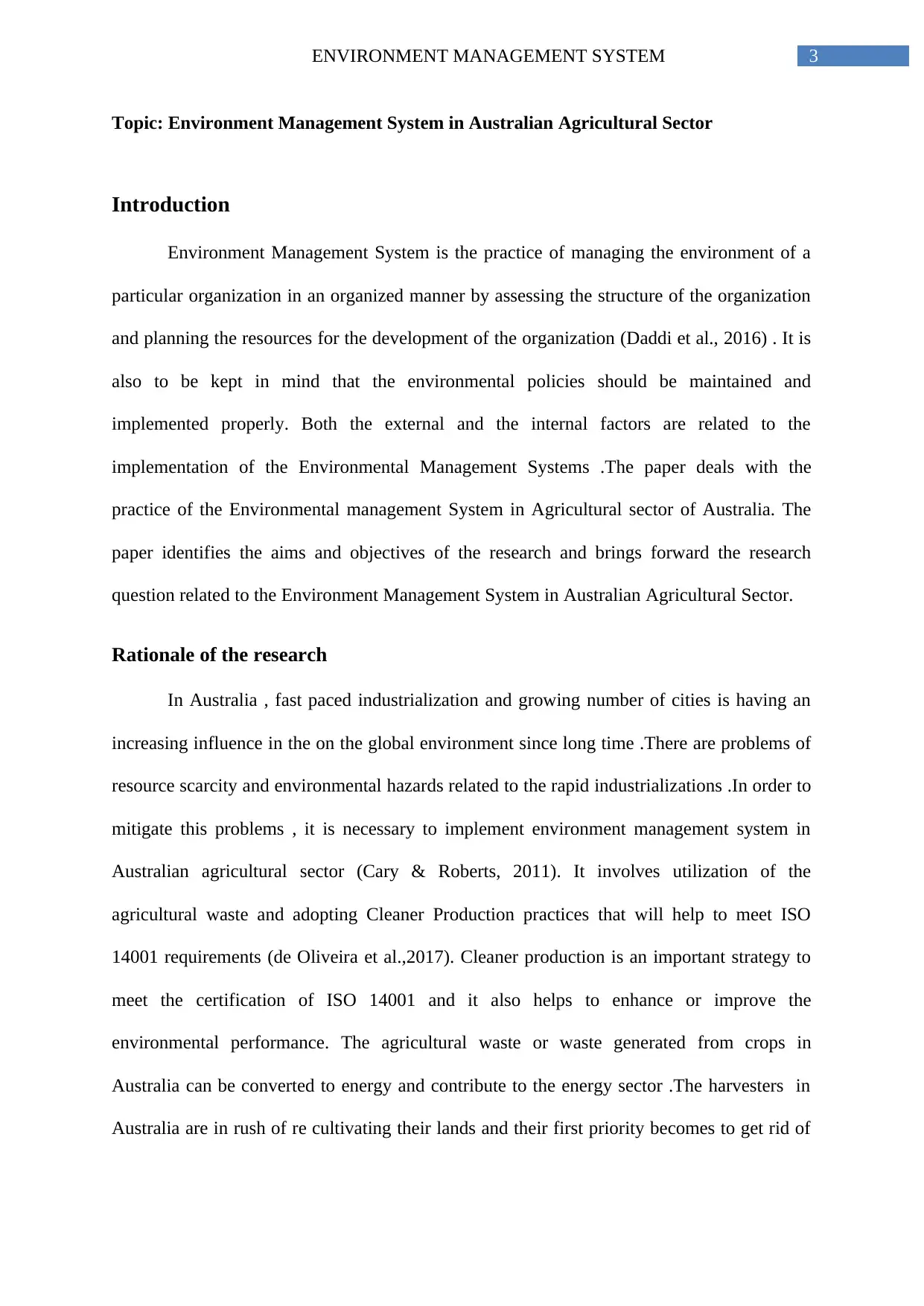
3ENVIRONMENT MANAGEMENT SYSTEM
Topic: Environment Management System in Australian Agricultural Sector
Introduction
Environment Management System is the practice of managing the environment of a
particular organization in an organized manner by assessing the structure of the organization
and planning the resources for the development of the organization (Daddi et al., 2016) . It is
also to be kept in mind that the environmental policies should be maintained and
implemented properly. Both the external and the internal factors are related to the
implementation of the Environmental Management Systems .The paper deals with the
practice of the Environmental management System in Agricultural sector of Australia. The
paper identifies the aims and objectives of the research and brings forward the research
question related to the Environment Management System in Australian Agricultural Sector.
Rationale of the research
In Australia , fast paced industrialization and growing number of cities is having an
increasing influence in the on the global environment since long time .There are problems of
resource scarcity and environmental hazards related to the rapid industrializations .In order to
mitigate this problems , it is necessary to implement environment management system in
Australian agricultural sector (Cary & Roberts, 2011). It involves utilization of the
agricultural waste and adopting Cleaner Production practices that will help to meet ISO
14001 requirements (de Oliveira et al.,2017). Cleaner production is an important strategy to
meet the certification of ISO 14001 and it also helps to enhance or improve the
environmental performance. The agricultural waste or waste generated from crops in
Australia can be converted to energy and contribute to the energy sector .The harvesters in
Australia are in rush of re cultivating their lands and their first priority becomes to get rid of
Topic: Environment Management System in Australian Agricultural Sector
Introduction
Environment Management System is the practice of managing the environment of a
particular organization in an organized manner by assessing the structure of the organization
and planning the resources for the development of the organization (Daddi et al., 2016) . It is
also to be kept in mind that the environmental policies should be maintained and
implemented properly. Both the external and the internal factors are related to the
implementation of the Environmental Management Systems .The paper deals with the
practice of the Environmental management System in Agricultural sector of Australia. The
paper identifies the aims and objectives of the research and brings forward the research
question related to the Environment Management System in Australian Agricultural Sector.
Rationale of the research
In Australia , fast paced industrialization and growing number of cities is having an
increasing influence in the on the global environment since long time .There are problems of
resource scarcity and environmental hazards related to the rapid industrializations .In order to
mitigate this problems , it is necessary to implement environment management system in
Australian agricultural sector (Cary & Roberts, 2011). It involves utilization of the
agricultural waste and adopting Cleaner Production practices that will help to meet ISO
14001 requirements (de Oliveira et al.,2017). Cleaner production is an important strategy to
meet the certification of ISO 14001 and it also helps to enhance or improve the
environmental performance. The agricultural waste or waste generated from crops in
Australia can be converted to energy and contribute to the energy sector .The harvesters in
Australia are in rush of re cultivating their lands and their first priority becomes to get rid of
Paraphrase This Document
Need a fresh take? Get an instant paraphrase of this document with our AI Paraphraser
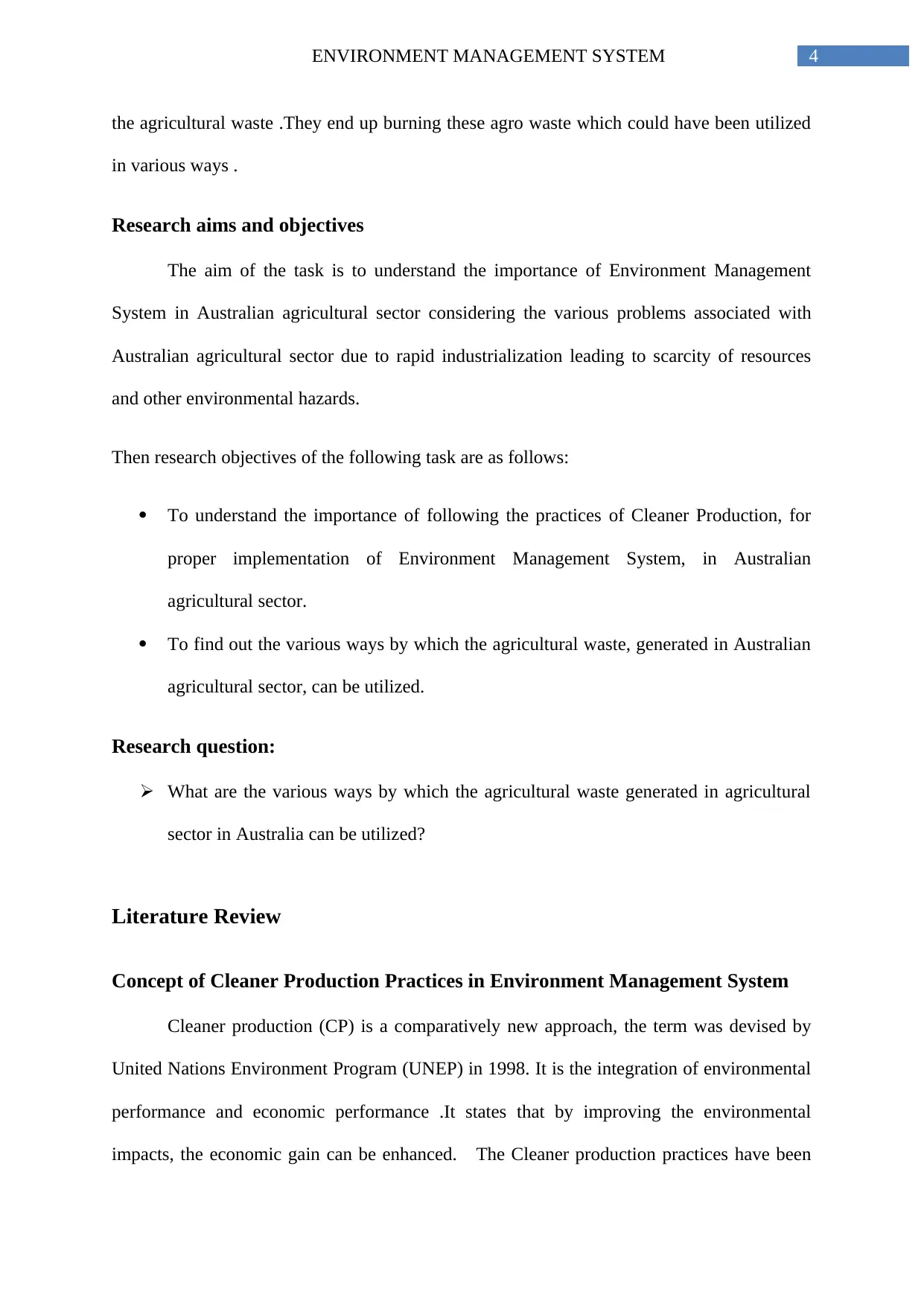
4ENVIRONMENT MANAGEMENT SYSTEM
the agricultural waste .They end up burning these agro waste which could have been utilized
in various ways .
Research aims and objectives
The aim of the task is to understand the importance of Environment Management
System in Australian agricultural sector considering the various problems associated with
Australian agricultural sector due to rapid industrialization leading to scarcity of resources
and other environmental hazards.
Then research objectives of the following task are as follows:
To understand the importance of following the practices of Cleaner Production, for
proper implementation of Environment Management System, in Australian
agricultural sector.
To find out the various ways by which the agricultural waste, generated in Australian
agricultural sector, can be utilized.
Research question:
What are the various ways by which the agricultural waste generated in agricultural
sector in Australia can be utilized?
Literature Review
Concept of Cleaner Production Practices in Environment Management System
Cleaner production (CP) is a comparatively new approach, the term was devised by
United Nations Environment Program (UNEP) in 1998. It is the integration of environmental
performance and economic performance .It states that by improving the environmental
impacts, the economic gain can be enhanced. The Cleaner production practices have been
the agricultural waste .They end up burning these agro waste which could have been utilized
in various ways .
Research aims and objectives
The aim of the task is to understand the importance of Environment Management
System in Australian agricultural sector considering the various problems associated with
Australian agricultural sector due to rapid industrialization leading to scarcity of resources
and other environmental hazards.
Then research objectives of the following task are as follows:
To understand the importance of following the practices of Cleaner Production, for
proper implementation of Environment Management System, in Australian
agricultural sector.
To find out the various ways by which the agricultural waste, generated in Australian
agricultural sector, can be utilized.
Research question:
What are the various ways by which the agricultural waste generated in agricultural
sector in Australia can be utilized?
Literature Review
Concept of Cleaner Production Practices in Environment Management System
Cleaner production (CP) is a comparatively new approach, the term was devised by
United Nations Environment Program (UNEP) in 1998. It is the integration of environmental
performance and economic performance .It states that by improving the environmental
impacts, the economic gain can be enhanced. The Cleaner production practices have been
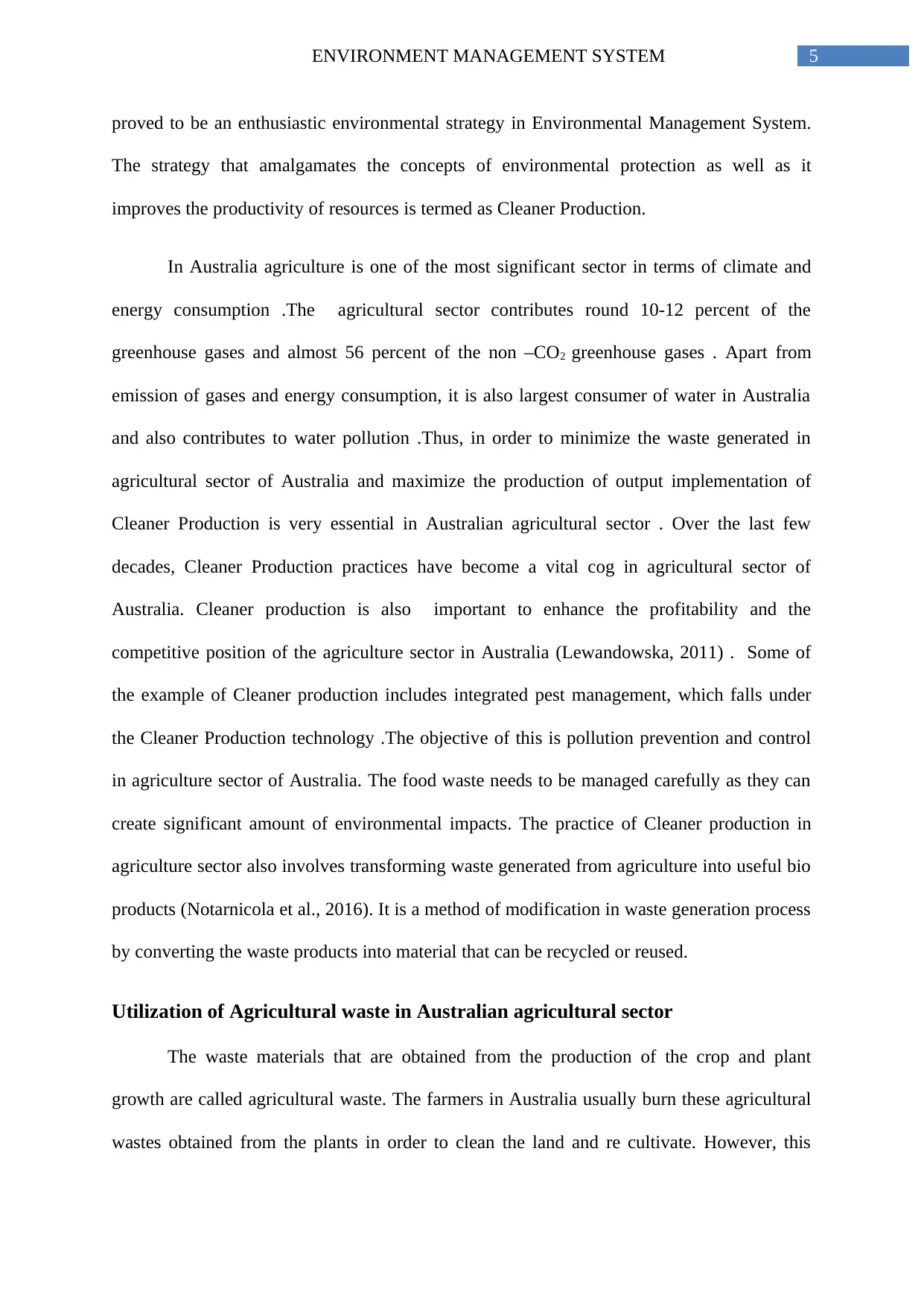
5ENVIRONMENT MANAGEMENT SYSTEM
proved to be an enthusiastic environmental strategy in Environmental Management System.
The strategy that amalgamates the concepts of environmental protection as well as it
improves the productivity of resources is termed as Cleaner Production.
In Australia agriculture is one of the most significant sector in terms of climate and
energy consumption .The agricultural sector contributes round 10-12 percent of the
greenhouse gases and almost 56 percent of the non –CO2 greenhouse gases . Apart from
emission of gases and energy consumption, it is also largest consumer of water in Australia
and also contributes to water pollution .Thus, in order to minimize the waste generated in
agricultural sector of Australia and maximize the production of output implementation of
Cleaner Production is very essential in Australian agricultural sector . Over the last few
decades, Cleaner Production practices have become a vital cog in agricultural sector of
Australia. Cleaner production is also important to enhance the profitability and the
competitive position of the agriculture sector in Australia (Lewandowska, 2011) . Some of
the example of Cleaner production includes integrated pest management, which falls under
the Cleaner Production technology .The objective of this is pollution prevention and control
in agriculture sector of Australia. The food waste needs to be managed carefully as they can
create significant amount of environmental impacts. The practice of Cleaner production in
agriculture sector also involves transforming waste generated from agriculture into useful bio
products (Notarnicola et al., 2016). It is a method of modification in waste generation process
by converting the waste products into material that can be recycled or reused.
Utilization of Agricultural waste in Australian agricultural sector
The waste materials that are obtained from the production of the crop and plant
growth are called agricultural waste. The farmers in Australia usually burn these agricultural
wastes obtained from the plants in order to clean the land and re cultivate. However, this
proved to be an enthusiastic environmental strategy in Environmental Management System.
The strategy that amalgamates the concepts of environmental protection as well as it
improves the productivity of resources is termed as Cleaner Production.
In Australia agriculture is one of the most significant sector in terms of climate and
energy consumption .The agricultural sector contributes round 10-12 percent of the
greenhouse gases and almost 56 percent of the non –CO2 greenhouse gases . Apart from
emission of gases and energy consumption, it is also largest consumer of water in Australia
and also contributes to water pollution .Thus, in order to minimize the waste generated in
agricultural sector of Australia and maximize the production of output implementation of
Cleaner Production is very essential in Australian agricultural sector . Over the last few
decades, Cleaner Production practices have become a vital cog in agricultural sector of
Australia. Cleaner production is also important to enhance the profitability and the
competitive position of the agriculture sector in Australia (Lewandowska, 2011) . Some of
the example of Cleaner production includes integrated pest management, which falls under
the Cleaner Production technology .The objective of this is pollution prevention and control
in agriculture sector of Australia. The food waste needs to be managed carefully as they can
create significant amount of environmental impacts. The practice of Cleaner production in
agriculture sector also involves transforming waste generated from agriculture into useful bio
products (Notarnicola et al., 2016). It is a method of modification in waste generation process
by converting the waste products into material that can be recycled or reused.
Utilization of Agricultural waste in Australian agricultural sector
The waste materials that are obtained from the production of the crop and plant
growth are called agricultural waste. The farmers in Australia usually burn these agricultural
wastes obtained from the plants in order to clean the land and re cultivate. However, this
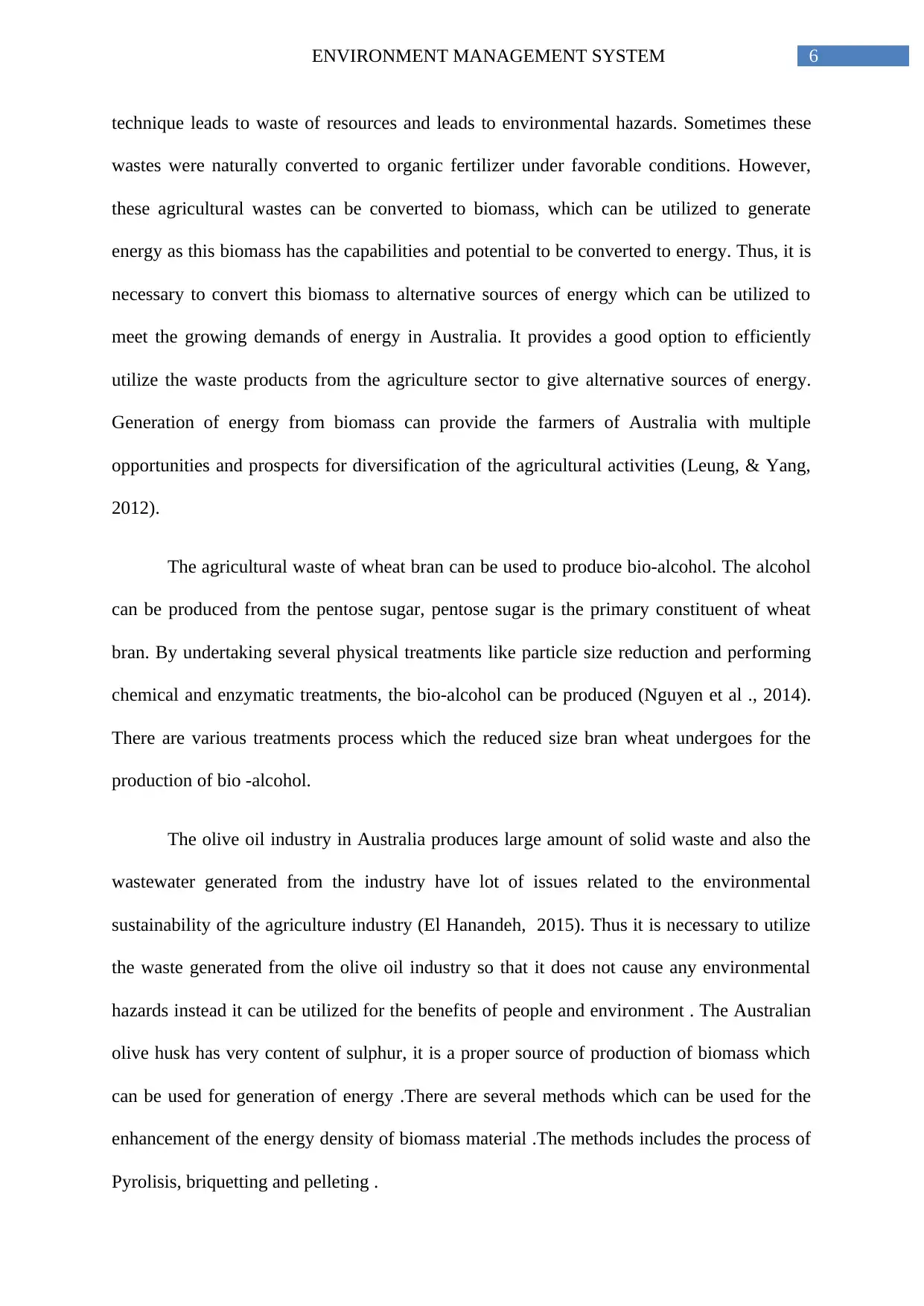
6ENVIRONMENT MANAGEMENT SYSTEM
technique leads to waste of resources and leads to environmental hazards. Sometimes these
wastes were naturally converted to organic fertilizer under favorable conditions. However,
these agricultural wastes can be converted to biomass, which can be utilized to generate
energy as this biomass has the capabilities and potential to be converted to energy. Thus, it is
necessary to convert this biomass to alternative sources of energy which can be utilized to
meet the growing demands of energy in Australia. It provides a good option to efficiently
utilize the waste products from the agriculture sector to give alternative sources of energy.
Generation of energy from biomass can provide the farmers of Australia with multiple
opportunities and prospects for diversification of the agricultural activities (Leung, & Yang,
2012).
The agricultural waste of wheat bran can be used to produce bio-alcohol. The alcohol
can be produced from the pentose sugar, pentose sugar is the primary constituent of wheat
bran. By undertaking several physical treatments like particle size reduction and performing
chemical and enzymatic treatments, the bio-alcohol can be produced (Nguyen et al ., 2014).
There are various treatments process which the reduced size bran wheat undergoes for the
production of bio -alcohol.
The olive oil industry in Australia produces large amount of solid waste and also the
wastewater generated from the industry have lot of issues related to the environmental
sustainability of the agriculture industry (El Hanandeh, 2015). Thus it is necessary to utilize
the waste generated from the olive oil industry so that it does not cause any environmental
hazards instead it can be utilized for the benefits of people and environment . The Australian
olive husk has very content of sulphur, it is a proper source of production of biomass which
can be used for generation of energy .There are several methods which can be used for the
enhancement of the energy density of biomass material .The methods includes the process of
Pyrolisis, briquetting and pelleting .
technique leads to waste of resources and leads to environmental hazards. Sometimes these
wastes were naturally converted to organic fertilizer under favorable conditions. However,
these agricultural wastes can be converted to biomass, which can be utilized to generate
energy as this biomass has the capabilities and potential to be converted to energy. Thus, it is
necessary to convert this biomass to alternative sources of energy which can be utilized to
meet the growing demands of energy in Australia. It provides a good option to efficiently
utilize the waste products from the agriculture sector to give alternative sources of energy.
Generation of energy from biomass can provide the farmers of Australia with multiple
opportunities and prospects for diversification of the agricultural activities (Leung, & Yang,
2012).
The agricultural waste of wheat bran can be used to produce bio-alcohol. The alcohol
can be produced from the pentose sugar, pentose sugar is the primary constituent of wheat
bran. By undertaking several physical treatments like particle size reduction and performing
chemical and enzymatic treatments, the bio-alcohol can be produced (Nguyen et al ., 2014).
There are various treatments process which the reduced size bran wheat undergoes for the
production of bio -alcohol.
The olive oil industry in Australia produces large amount of solid waste and also the
wastewater generated from the industry have lot of issues related to the environmental
sustainability of the agriculture industry (El Hanandeh, 2015). Thus it is necessary to utilize
the waste generated from the olive oil industry so that it does not cause any environmental
hazards instead it can be utilized for the benefits of people and environment . The Australian
olive husk has very content of sulphur, it is a proper source of production of biomass which
can be used for generation of energy .There are several methods which can be used for the
enhancement of the energy density of biomass material .The methods includes the process of
Pyrolisis, briquetting and pelleting .
Secure Best Marks with AI Grader
Need help grading? Try our AI Grader for instant feedback on your assignments.
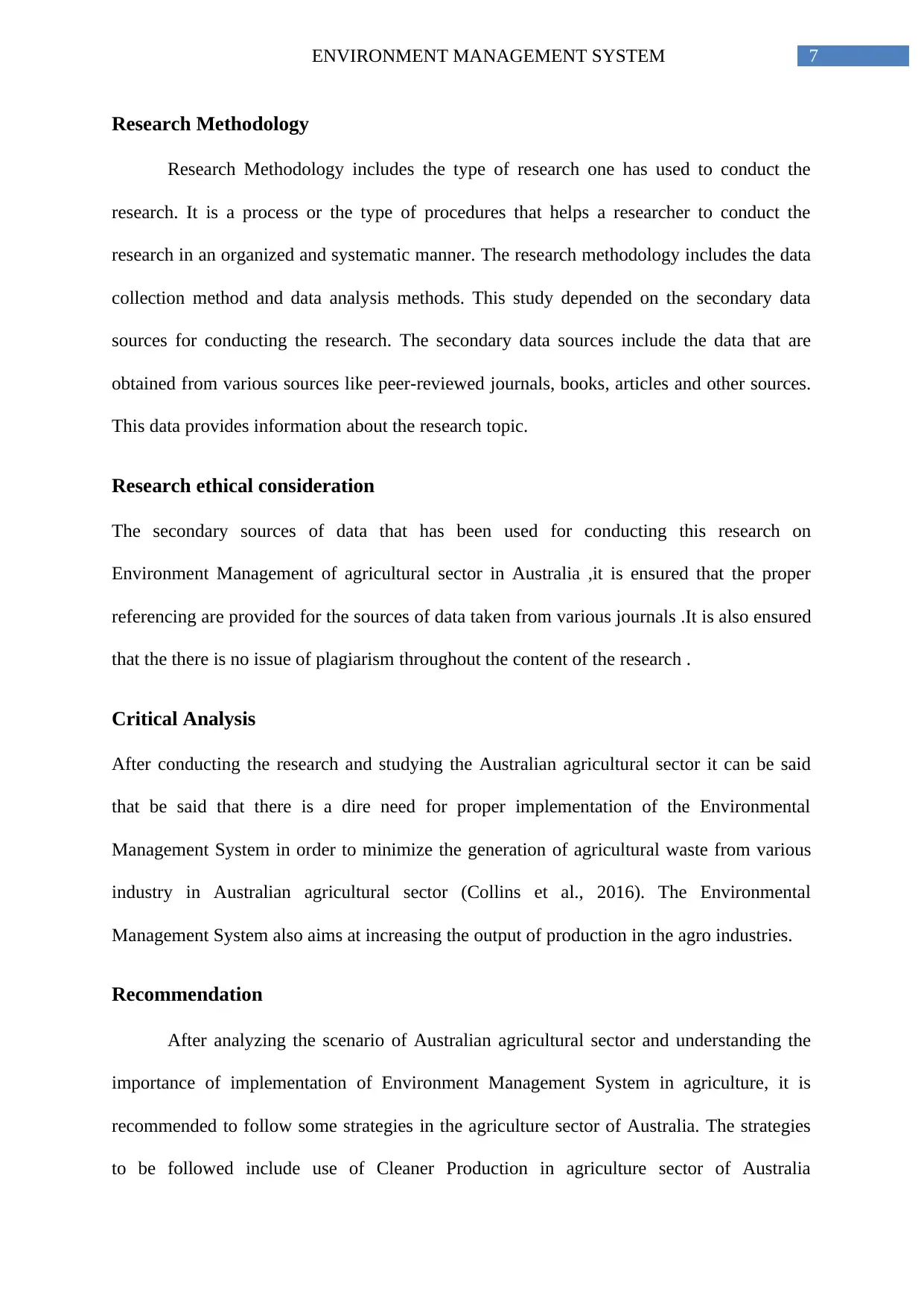
7ENVIRONMENT MANAGEMENT SYSTEM
Research Methodology
Research Methodology includes the type of research one has used to conduct the
research. It is a process or the type of procedures that helps a researcher to conduct the
research in an organized and systematic manner. The research methodology includes the data
collection method and data analysis methods. This study depended on the secondary data
sources for conducting the research. The secondary data sources include the data that are
obtained from various sources like peer-reviewed journals, books, articles and other sources.
This data provides information about the research topic.
Research ethical consideration
The secondary sources of data that has been used for conducting this research on
Environment Management of agricultural sector in Australia ,it is ensured that the proper
referencing are provided for the sources of data taken from various journals .It is also ensured
that the there is no issue of plagiarism throughout the content of the research .
Critical Analysis
After conducting the research and studying the Australian agricultural sector it can be said
that be said that there is a dire need for proper implementation of the Environmental
Management System in order to minimize the generation of agricultural waste from various
industry in Australian agricultural sector (Collins et al., 2016). The Environmental
Management System also aims at increasing the output of production in the agro industries.
Recommendation
After analyzing the scenario of Australian agricultural sector and understanding the
importance of implementation of Environment Management System in agriculture, it is
recommended to follow some strategies in the agriculture sector of Australia. The strategies
to be followed include use of Cleaner Production in agriculture sector of Australia
Research Methodology
Research Methodology includes the type of research one has used to conduct the
research. It is a process or the type of procedures that helps a researcher to conduct the
research in an organized and systematic manner. The research methodology includes the data
collection method and data analysis methods. This study depended on the secondary data
sources for conducting the research. The secondary data sources include the data that are
obtained from various sources like peer-reviewed journals, books, articles and other sources.
This data provides information about the research topic.
Research ethical consideration
The secondary sources of data that has been used for conducting this research on
Environment Management of agricultural sector in Australia ,it is ensured that the proper
referencing are provided for the sources of data taken from various journals .It is also ensured
that the there is no issue of plagiarism throughout the content of the research .
Critical Analysis
After conducting the research and studying the Australian agricultural sector it can be said
that be said that there is a dire need for proper implementation of the Environmental
Management System in order to minimize the generation of agricultural waste from various
industry in Australian agricultural sector (Collins et al., 2016). The Environmental
Management System also aims at increasing the output of production in the agro industries.
Recommendation
After analyzing the scenario of Australian agricultural sector and understanding the
importance of implementation of Environment Management System in agriculture, it is
recommended to follow some strategies in the agriculture sector of Australia. The strategies
to be followed include use of Cleaner Production in agriculture sector of Australia
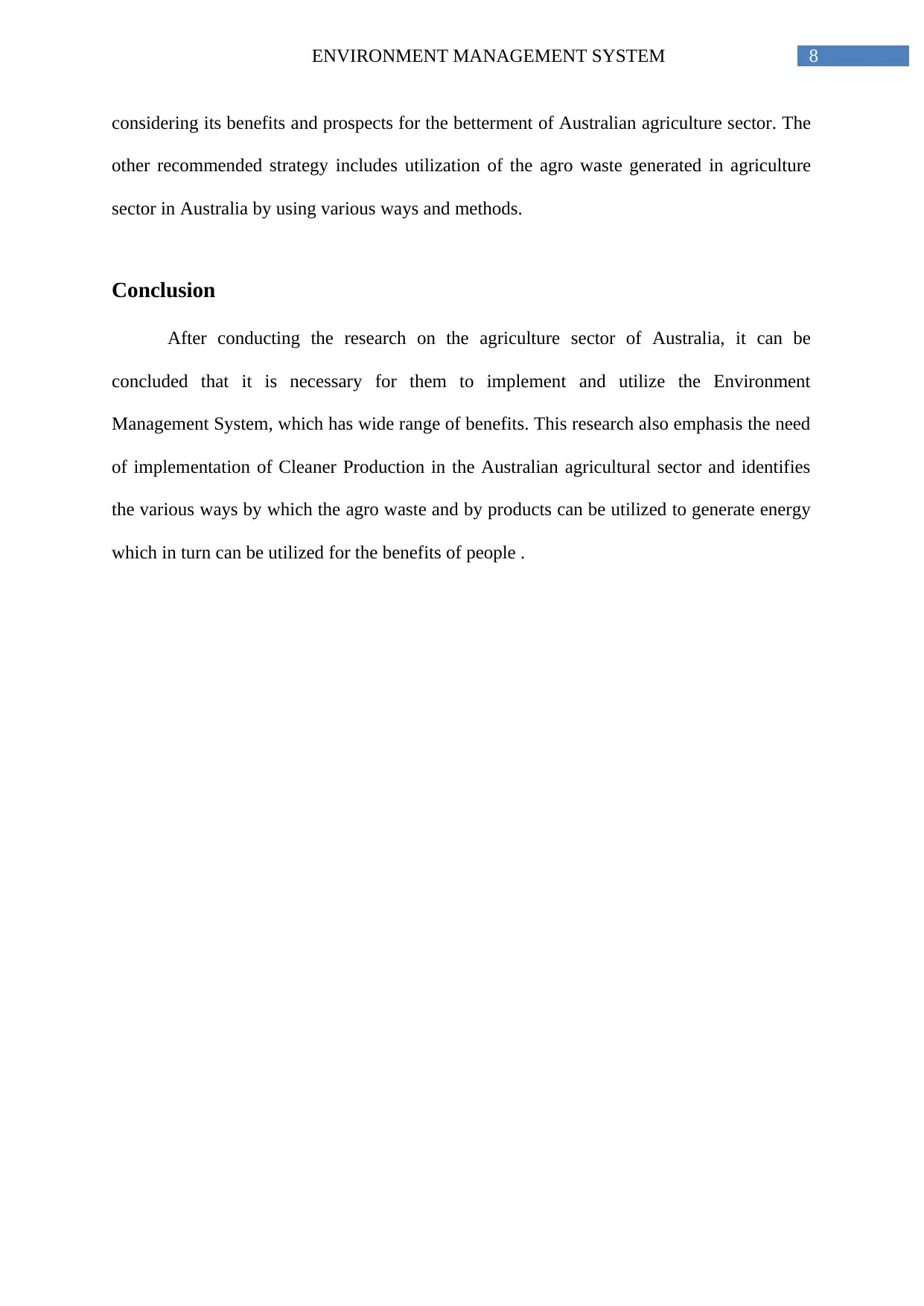
8ENVIRONMENT MANAGEMENT SYSTEM
considering its benefits and prospects for the betterment of Australian agriculture sector. The
other recommended strategy includes utilization of the agro waste generated in agriculture
sector in Australia by using various ways and methods.
Conclusion
After conducting the research on the agriculture sector of Australia, it can be
concluded that it is necessary for them to implement and utilize the Environment
Management System, which has wide range of benefits. This research also emphasis the need
of implementation of Cleaner Production in the Australian agricultural sector and identifies
the various ways by which the agro waste and by products can be utilized to generate energy
which in turn can be utilized for the benefits of people .
considering its benefits and prospects for the betterment of Australian agriculture sector. The
other recommended strategy includes utilization of the agro waste generated in agriculture
sector in Australia by using various ways and methods.
Conclusion
After conducting the research on the agriculture sector of Australia, it can be
concluded that it is necessary for them to implement and utilize the Environment
Management System, which has wide range of benefits. This research also emphasis the need
of implementation of Cleaner Production in the Australian agricultural sector and identifies
the various ways by which the agro waste and by products can be utilized to generate energy
which in turn can be utilized for the benefits of people .
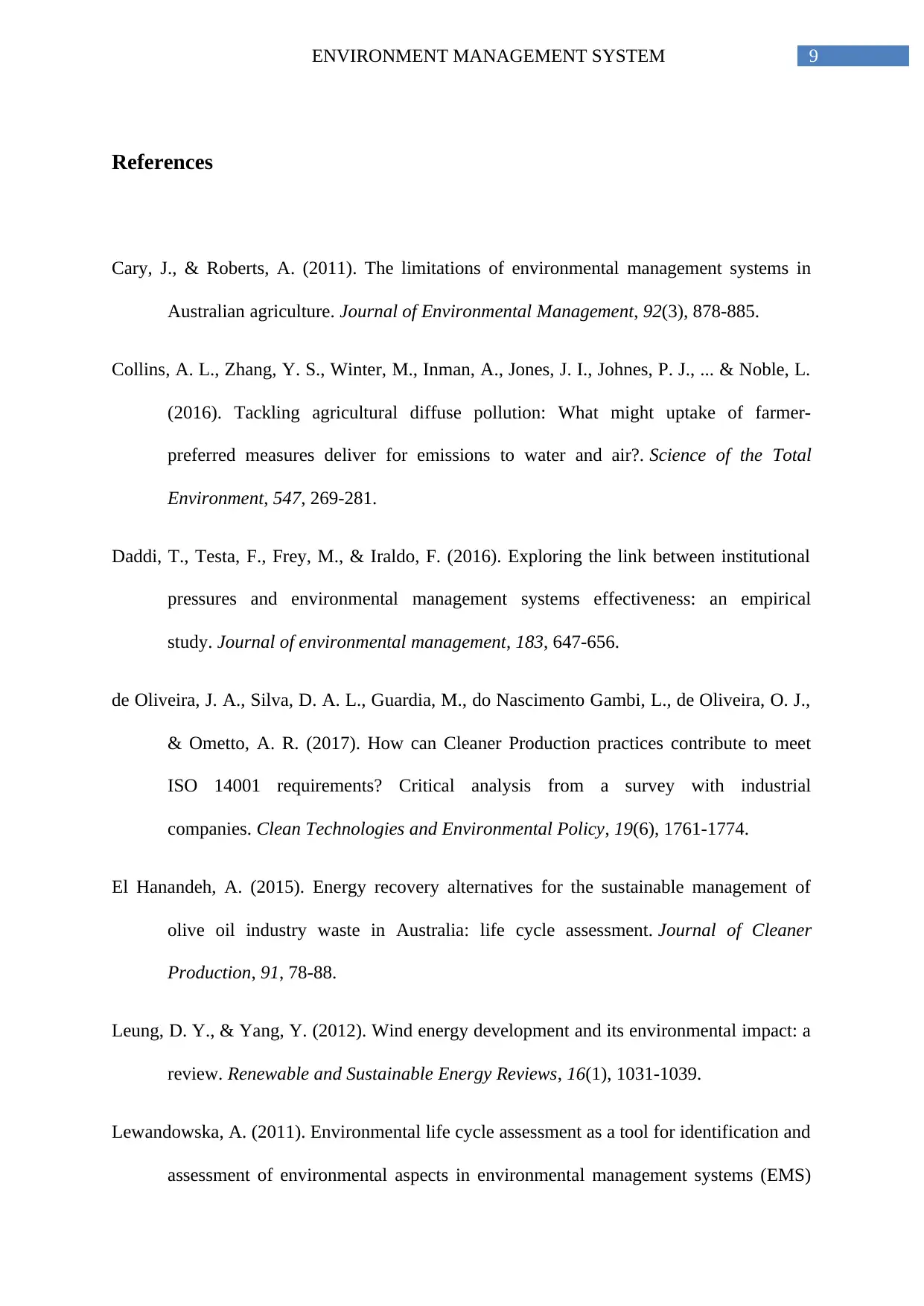
9ENVIRONMENT MANAGEMENT SYSTEM
References
Cary, J., & Roberts, A. (2011). The limitations of environmental management systems in
Australian agriculture. Journal of Environmental Management, 92(3), 878-885.
Collins, A. L., Zhang, Y. S., Winter, M., Inman, A., Jones, J. I., Johnes, P. J., ... & Noble, L.
(2016). Tackling agricultural diffuse pollution: What might uptake of farmer-
preferred measures deliver for emissions to water and air?. Science of the Total
Environment, 547, 269-281.
Daddi, T., Testa, F., Frey, M., & Iraldo, F. (2016). Exploring the link between institutional
pressures and environmental management systems effectiveness: an empirical
study. Journal of environmental management, 183, 647-656.
de Oliveira, J. A., Silva, D. A. L., Guardia, M., do Nascimento Gambi, L., de Oliveira, O. J.,
& Ometto, A. R. (2017). How can Cleaner Production practices contribute to meet
ISO 14001 requirements? Critical analysis from a survey with industrial
companies. Clean Technologies and Environmental Policy, 19(6), 1761-1774.
El Hanandeh, A. (2015). Energy recovery alternatives for the sustainable management of
olive oil industry waste in Australia: life cycle assessment. Journal of Cleaner
Production, 91, 78-88.
Leung, D. Y., & Yang, Y. (2012). Wind energy development and its environmental impact: a
review. Renewable and Sustainable Energy Reviews, 16(1), 1031-1039.
Lewandowska, A. (2011). Environmental life cycle assessment as a tool for identification and
assessment of environmental aspects in environmental management systems (EMS)
References
Cary, J., & Roberts, A. (2011). The limitations of environmental management systems in
Australian agriculture. Journal of Environmental Management, 92(3), 878-885.
Collins, A. L., Zhang, Y. S., Winter, M., Inman, A., Jones, J. I., Johnes, P. J., ... & Noble, L.
(2016). Tackling agricultural diffuse pollution: What might uptake of farmer-
preferred measures deliver for emissions to water and air?. Science of the Total
Environment, 547, 269-281.
Daddi, T., Testa, F., Frey, M., & Iraldo, F. (2016). Exploring the link between institutional
pressures and environmental management systems effectiveness: an empirical
study. Journal of environmental management, 183, 647-656.
de Oliveira, J. A., Silva, D. A. L., Guardia, M., do Nascimento Gambi, L., de Oliveira, O. J.,
& Ometto, A. R. (2017). How can Cleaner Production practices contribute to meet
ISO 14001 requirements? Critical analysis from a survey with industrial
companies. Clean Technologies and Environmental Policy, 19(6), 1761-1774.
El Hanandeh, A. (2015). Energy recovery alternatives for the sustainable management of
olive oil industry waste in Australia: life cycle assessment. Journal of Cleaner
Production, 91, 78-88.
Leung, D. Y., & Yang, Y. (2012). Wind energy development and its environmental impact: a
review. Renewable and Sustainable Energy Reviews, 16(1), 1031-1039.
Lewandowska, A. (2011). Environmental life cycle assessment as a tool for identification and
assessment of environmental aspects in environmental management systems (EMS)
Paraphrase This Document
Need a fresh take? Get an instant paraphrase of this document with our AI Paraphraser
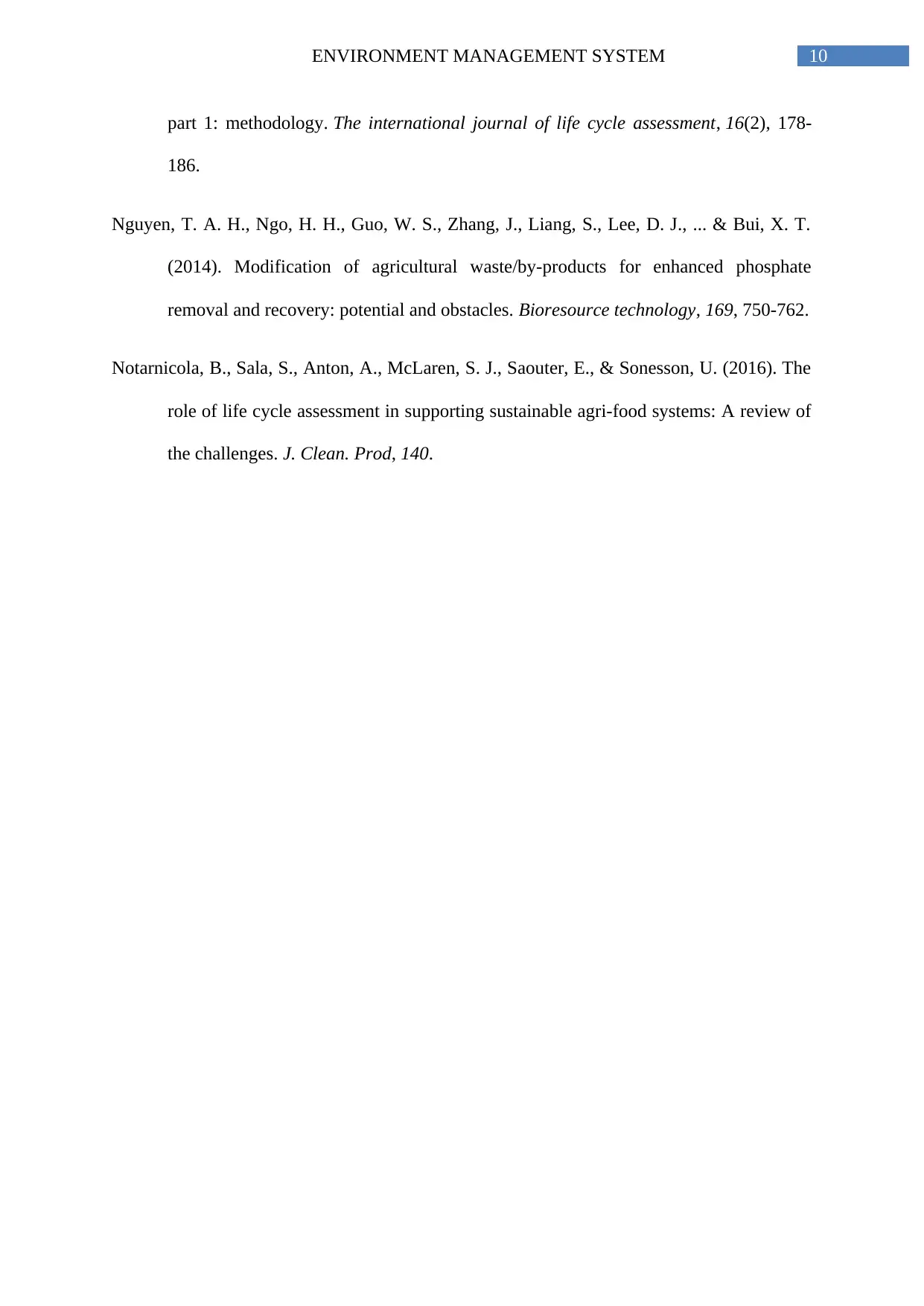
10ENVIRONMENT MANAGEMENT SYSTEM
part 1: methodology. The international journal of life cycle assessment, 16(2), 178-
186.
Nguyen, T. A. H., Ngo, H. H., Guo, W. S., Zhang, J., Liang, S., Lee, D. J., ... & Bui, X. T.
(2014). Modification of agricultural waste/by-products for enhanced phosphate
removal and recovery: potential and obstacles. Bioresource technology, 169, 750-762.
Notarnicola, B., Sala, S., Anton, A., McLaren, S. J., Saouter, E., & Sonesson, U. (2016). The
role of life cycle assessment in supporting sustainable agri-food systems: A review of
the challenges. J. Clean. Prod, 140.
part 1: methodology. The international journal of life cycle assessment, 16(2), 178-
186.
Nguyen, T. A. H., Ngo, H. H., Guo, W. S., Zhang, J., Liang, S., Lee, D. J., ... & Bui, X. T.
(2014). Modification of agricultural waste/by-products for enhanced phosphate
removal and recovery: potential and obstacles. Bioresource technology, 169, 750-762.
Notarnicola, B., Sala, S., Anton, A., McLaren, S. J., Saouter, E., & Sonesson, U. (2016). The
role of life cycle assessment in supporting sustainable agri-food systems: A review of
the challenges. J. Clean. Prod, 140.
1 out of 11
![[object Object]](/_next/static/media/star-bottom.7253800d.svg)





